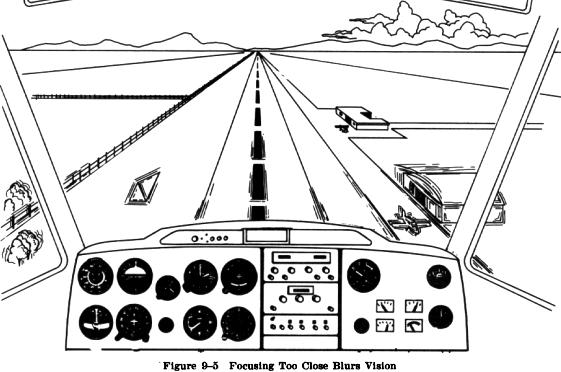
During the approach, roundout, and touchdown, vision is of prime importance. To provide a wide scope of vision and to foster good judgment of height and movement, the pilot's head should assume a natural, straight ahead position. The pilot's visual focus should not be fixed on any one side or any one spot ahead of the airplane, but should be changing slowly from a point just over the airplane's nose to the desired touchdown zone and back again, while maintaining a deliberate awareness of distance from either side of the runway within the pilot's peripheral field of vision.
Accurate estimation of distance is, besides being a matter of practice, dependent upon how clearly objects are seen; it requires that the vision be focused properly in order that the important objects stand out as clearly as possible.
Speed in particular, blurs objects at close range (Fig. 9-5). Most everyone has noted this in an automobile moving at high speed. Nearby objects seem to merge together in a blur, while objects farther away stand out clearly. The driver subconsciously focuses the eyes sufficiently far ahead of the automobile to see objects distinctly.

Similarly, the distance at which the pilot's vision is focused should be proportionate to the speed at which the airplane is traveling over the ground. Thus, as speed is reduced during the roundout, the distance ahead of the airplane at which it is possible to focus should be brought closer accordingly.
If the pilot attempts to focus on references that are too close or looks directly down, the references become blurred, and reactions will be either too abrupt or too late. In this case the pilot's tendency will be to overcontrol, roundout high, and make full stall "drop in" landings. When the pilot focuses too far ahead, accuracy in judging the closeness of the ground is lost and the consequent reactions will be slow since there will appear to be no necessity for any action, resulting in the airplane flying into the ground, nose first. The change of visual focus from a long distance to a short distance requires a definite time interval and, even though the time is brief, the airplane's speed during this interval is such that the airplane travels an appreciable distance, both forward and downward toward the ground.
If the focus is changed gradually, being brought progressively closer as speed is reduced, the time interval and the attendant pilot reactions will be reduced, and the whole landing process smoothed out.